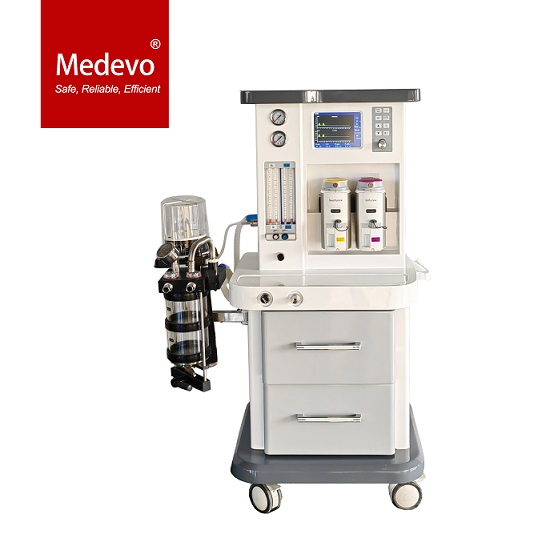The Structure of Anesthesia Machine
The Structure of Anesthesia Machine
Anesthesia machine is an indispensable equipment for clinical anesthesia. Its main structures include:
1. Gas source: mainly refers to the storage equipment that supplies oxygen and N2O, with liquid oxygen in steel cylinders or a central gas supply source. After the force regulator reduces the pressure to 343-392kPa, it is supplied to the anesthesia machine for use. Adjust the fresh air flow rate through the gas flow meter. To quickly inflate the breathing system. Equipped with a quick inflation valve.
2. Evaporator: The evaporator can effectively evaporate volatile anesthetic liquid into gas and accurately adjust the concentration of anesthetic vapor output. Temperature-flow compensation evaporator: When the anesthesia machine undergoes changes in temperature and gas flow, it can maintain a stable output concentration through an automatic compensation mechanism. Evaporators have drug specificity, such as enflurane evaporators, isoprotene evaporators, etc. Placed outside the respiratory circuit, there is an independent bypass supply system. When the volatilizer is turned on, the bypass airflow passes through the evaporation chamber, and the well carries anesthetic gas mixed with the main airflow before entering the loop, making the suction concentration more stable. However, during rapid inflation, the concentration of anesthetic in the loop can be reduced due to its ability to dilute without passing through the evaporator, resulting in a decrease in inhaled concentration
3. Respiratory circuit system: Fresh gas inhaled anesthetics are delivered to the patient's respiratory tract through the respiratory circuit system, and the exhaled gas is expelled.
Common loop systems include:
(1) Open type: In an open type, the patient's breathing is not controlled by anesthesia equipment, and the inhaled or exhaled gas can freely enter and exit the atmosphere, and the exhaled CO2 has no repeated inhalation phenomenon.
(2) Semi closed or semi open: The gas exhaled or inhaled by the patient is partially controlled by anesthesia equipment, and there is an expiratory chamber in the respiratory circuit, but it does not enter the absorber. The amount of exhalation from the exhaled valve during exhalation depends on the resistance of the valve and the amount of fresh air flow. At the minimum fresh air flow, some exhaled gases, including CO2 and anesthetic gases, enter the breathing bag. When breathing again, they are repeatedly inhaled. When the repeated inhalation of CO2 exceeds 1% of the volume, it is called a semi closed type; If most of the exhaled gas is discharged into the atmosphere when fresh air enters, it is advisable to re inhale CO2 with a volume of less than 1%, which is called a semi open type.
(3) Tight closed: The patient's exhaled and inhaled gases are completely controlled by the anesthesia equipment. Therefore, a CO2 absorber must be installed in the respiratory circuit. The exhaled gas is absorbed by a CO2 absorber. Part or all of it is transported back to the patient's respiratory tract. The commonly used CO2 absorber is sodium lime, and when sodium lime fails, CO2 accumulation can occur. Nowadays, circular breathing circuits are commonly used, and when using closed breathing, it is feasible to assist or control breathing for patients in respiratory management. Anesthetics in exhaled gas can be recycled. Not only does it save anesthesia, but it also reduces environmental pollution. It can maintain the temperature and humidity of the inhaled gas close to the physiological state, but the structure is more complex than before, with greater respiratory resistance. The integrated part of the tight respiratory circuit includes: access joint, threaded tube, respiratory valve, expiratory valve, CO2 absorber, and respiration.
4. Anesthetic respirator: During anesthesia, a respirator can be used to control the patient's breathing. There are two types: constant volume and constant pressure. Respiratory parameters such as tidal maximum, minute ventilation, airway pressure, respiratory pause rate, and inspiratory to expiratory time ratio can be set. Sometimes, positive end expiratory pressure can also be set, and the reporting limits for inhaled oxygen concentration, minute ventilation, and airway pressure can be set to ensure the safety of anesthesia.




